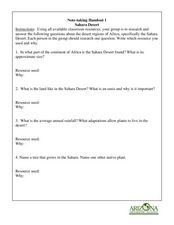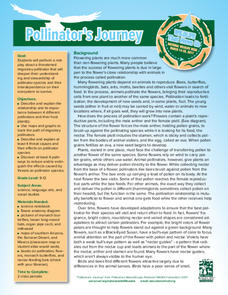Curated OER
Note-Taking Handout 1: Sahara Desert
For this research skills worksheet, learners collect information about the desert regions, savanna regions, and rainforest regions of Africa and then respond to 7 questions about each of the regions. Students then compare the regions...
Curated OER
Habitats of the World
Students discover that the Earth supports many different animal habitats. In this habitat lesson students research different habitats of the world. Students show how the animals in their habitat are adapted.
Curated OER
Dress Like A Frog
Students recognize amphibian adaptations. In this amphibian activity students explore amphibian adaptations that provide for successful living in their environments. A volunteer dresses up with all of the adaptations using everyday items...
American Museum of Natural History
Moving Mammals
How many different ways do mammals move from place to place? An online resource uses animation to show how different mammals move. Learners use a slider to speed up or slow down a variety of mammals. The versatile lesson works as a...
Curated OER
Turtle Adaptations
Students identify structural adaptations of different types of turtles, and compare and contrast adaptations of painted turtles, sea turtles, and desert tortoises using a chart.
Curated OER
Animal Adaptations to Various Environments
Fourth graders examine animal adaptatations for various animals and different environments throughout the year. They use the Internet to research these environments and apply them to the animals.
National Wildlife Federation
Pollinator's Journey: Grades 9-12
Gain a deeper understanding of migratory pollinators. After studying about pollinators and their effects on flowering plants, learners hear a story about the migration of Monarch butterflies and bats in the Sonoma Desert. Small groups...
Teacher Printables
My Report Pack for. . .
Here is a handy guide for putting together a research report on birds, or on a selection of other topics (see the added materials.). Individuals are guided to think of three questions about their topic, they narrow down subtopics, use a...
Pearson
Adjectives: Superlatives
Give the class the most interesting lesson yet with a fun grammar presentation on superlative adjectives. With animated slides and sound effects, the presentation is the greatest way to introduce proper usage.
Curated OER
ANIMALS OF ANTARCTICA
Students are introduced to the animals of Antarctica and how they adapt to their environment and the changes of the seasons after being read the story,"Counting Penguins" . They pick an animal and predict how he/she thinks this animal...
Curated OER
Design-A-Weed
Students create a "super weed" that prospers in teh harsh conditions on plant Weediv. They comprehend how weed adaptations give the plants an advantage over native plants. Students define the term adaptation. They give three examples...
Curated OER
Wildlife
The centerpiece of this lesson plan is a predator-prey simulation in which colored paperclips represent different species of animals camouflaged against a colored background. Relevant follow-up questions are provided. The activity is...
Curated OER
Patterns and Adaptations in Plants and Animals
Fourth graders conduct research about some of the regions of Texas. They compare plants and animals to identify different adaptations. The statistics of survival rates are measured for changes.
Curated OER
Your Favorite Wild Animal
In this research skills worksheet, students select a wild animal and then respond to 5 short answer questions regarding it. In addition, students draw a picture of it and define 6 habitat terms.
Curated OER
Happy Habitats
Students explore different habitats. In this habitat lesson, students investigate four different habitats through participating in a WebQuest. Students create an animal web using Kidspiration or a video documentary upon completing the...
Curated OER
In The Zone
Third graders identify ways that ocean animals grow, survive, reproduce, and adapt. They use computer Internet skills to acces and collect information. They create a PowerPoint presentation. They demonstrate writing skills throughthe...
Desert Discovery
Leaping Lizards
Here is a fine biology lesson that introduces youngsters to reptiles. They study their feeding habits, their habitats, and the adaptations they must make to survive in their environments. The outstanding lesson includes two excellent...
Curated OER
Habitats: Cactus Hotel
A reading of Brenda Z. Guiberson’s, Cactus Hotel, launches a study of animal habitats. Working with parent volunteers or teacher aides, groups travel outside the classroom to select a habitat, take digital pictures, and incorporate the...
Curated OER
Researching an Animal (Class Book)
Third graders research an animal in order to gain knowledge of the adaptations that allow it to survive in the desert. They present this information to the rest of the class in oral reports, and by contributing to the class book.
Curated OER
Terrestrial Communities
Young scholars watch a video about different terrestrial communities. They conduct an experiment with sponges conserving water. They research desert characteristics comparing them with other biomes.
Curated OER
Mother Nature's Laboratory
Students research how various plants and animals adapt over time to specific habitats and for specific purposes. Students produce a pictorial report on an example of an animal or plant's adaptation.
Curated OER
The Sidewinder and the Sidewinder
Learners compare and contrast the Sidewinder of the U.S. Southwest and the Namib Desert. They watch and discuss a video, complete a journal entry, color templates of both types of sidewinders, and discuss the differences between the two.
Curated OER
The Coyote Population: Kansas Prairies
Young scholars discover animal lifestyles by researching their ecosystem. In this animal statistics lesson, students research the geography of Kansas and discuss the reasons why wild animals survive in the open Kansas fields. Young...
Curated OER
Biomes of the World
In this biomes worksheet, students read an article on biomes and answer 10 multiple choice, short answer or true and false questions relating to biomes.

























